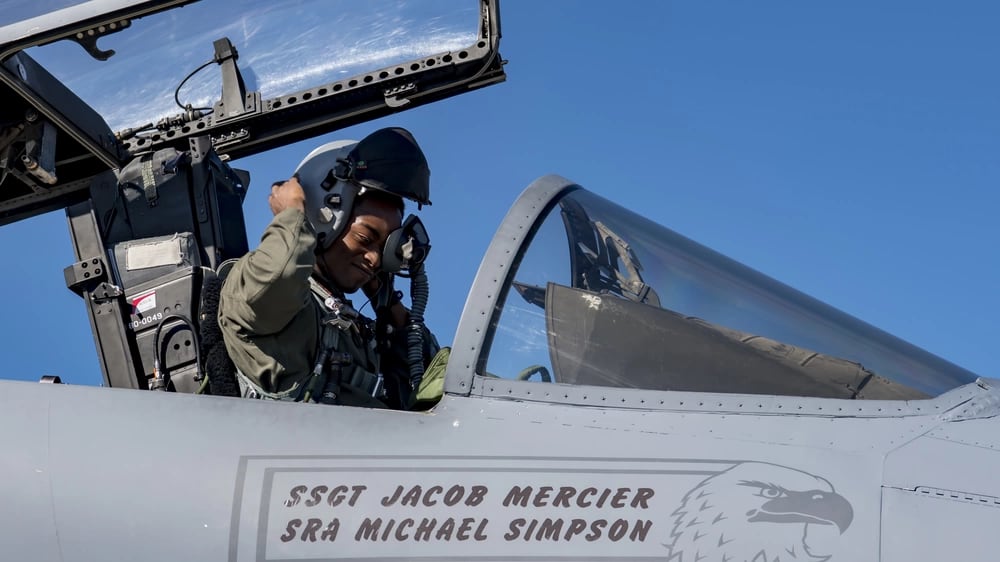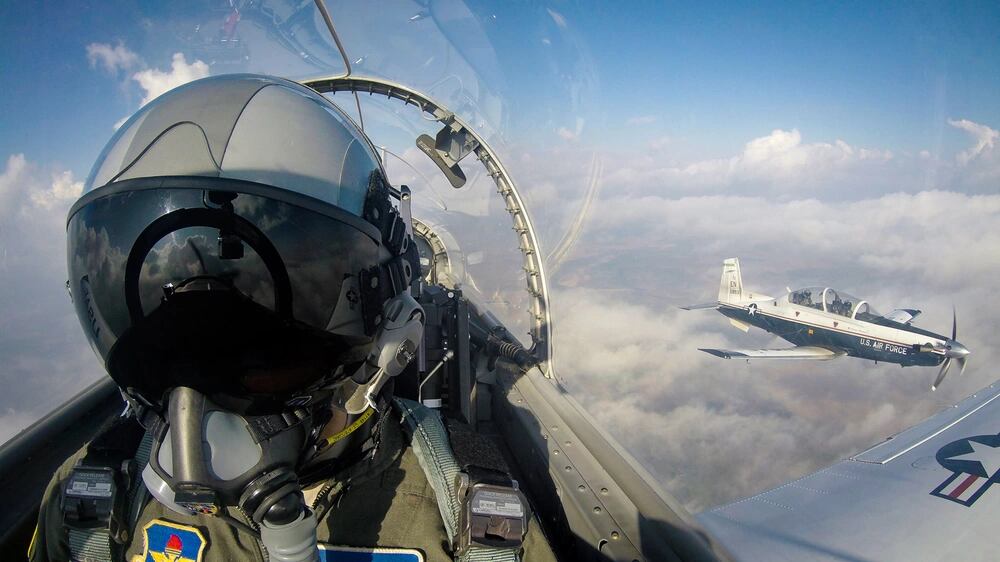The Air Force’s T-38 Talon training jet fleet is digging out of engine maintenance delays that could slow military pilot production for at least another six months.
Service officials say the main contractor, Arizona-based StandardAero, hasn’t delivered enough freshly refurbished engines to train American and foreign combat pilots. Those deliveries have lagged the usual rate for several months due to a web of complications.
The problem comes as the Air Force struggles with a growing pilot shortage that particularly affects the fighter community. T-38s are the Air Force’s sole intermediate platform for teaching airmen to fly fighter and bomber aircraft.
After months of intervention, however, the T-38 enterprise is beginning to see improvements.
“It’s an old engine. … There’s a lot of moving parts,” Air Education and Training Command boss Lt. Gen. Brian Robinson said Feb. 16 in an exclusive interview at Joint Base San Antonio-Randolph, Texas. “But as a customer, I just want to produce pilots.”
He said the Air Force has tried to give StandardAero the time and resources to get up to speed and meet their contractual requirements. That’s paid off: The J85 enterprise produced 30 engines as required in February, and it hopes to be able to service all parts in the next month or so, according to Air Force Materiel Command spokesperson Brian Brackens.
But the Air Force said it expects to see pilot training shortfalls through the end of the fiscal year, and that the J85 turbojet engine enterprise won’t fully recover until April 2024.
Air Force Materiel Command is “all hands on deck, talking to the company that won the contract: ‘Hey, you’ve got to start producing,’” Robinson said.
RELATED

The problems began with an effort to improve the engine’s long-term reliability.
The Air Force stopped using maintainers at Columbus Air Force Base, Mississippi, and Laughlin AFB, Texas, and decided to instead rely on an outside company to do full overhauls.
StandardAero won the $237 million multiyear contract to repair the GE J85 engines in May 2020. That placed the company as the sole contractor in charge of long-term maintenance, including any needed overhauls, testing, parts support and on-site service calls.
Officials expected the shift would “greatly improve J85 reliability and increase ‘time on [the] wing,’ resulting in more T-38 daily sorties,” Brackens said.
“StandardAero will offer the same high-quality service on the J85 contract as on other multiyear agreements, including the Rolls-Royce T56 engines that power C-130 aircraft and the GE F110 engines on F-15 and F-16 fighters,” the company said in a release at the time.

But several factors — including the coronavirus pandemic — got in the way, Brackens said:
- The Air Force already had trouble getting the right parts for the aging J85 under its previous approach.
- Efforts to build up a surplus of ready engines, hoping to bridge the gap while the old maintenance contract wound down and the new one began, failed because of COVID-19′s impact on staffing.
- The Air Force flew less than usual in fiscal 2020 and 2021, so less funding was allocated toward buying and repairing those aircraft parts.
- The military did not provide a complete list of acceptable parts for StandardAero to order.
- Equipment the government provided to the company was worn out and unserviceable.
So, the J85 enterprise bought fewer parts while demand for those components grew, thanks to the more intensive maintenance that the new contract required, Brackens said.
Together those factors “strained the system and throttled production,” causing StandardAero to fall behind on their contract requirements for nine months, he added. Also, the time it has taken to produce new parts means repairs have not kept pace with Air Force flight training needs for as long as 18 months.
Brighter outlook
Now those parts are arriving sooner, and engine repair rates have consistently improved over the past three months.

In a March 15 email to Air Force Times, StandardAero said it is “aware of, and sensitive to, the engine readiness levels situation.”
The company speaks to officials within the Air Force, Defense Logistics Agency and General Electric on a daily basis to make sure the supply chain is running smoothly, said StandardAero spokesperson Kyle Hultquist. The Air Force’s propulsion directorate within AFMC has been “very complimentary of our efforts to turn the program around,” he said.
“Our engine production has been at all-time program highs recently, with last month’s engine production at 30 engines,” he said. “We expect that production rate to continue [to] increase over time, which would provide the program with sustained production levels never before seen in the program.”
Hultquist said the company has seen metrics for engine reliability increase, while reducing material costs and better forecasting its future needs. StandardAero has flagged hundreds of changes needed in the engine’s technical manuals and is using predictive maintenance to catch failing parts before they create a problem.
“StandardAero is a long-time partner of the USAF and [foreign military sales] countries and is committed to the success of this and all of our military programs,” he said.

To help StandardAero along, the Air Force has sought workarounds to add some capacity back into its training pipeline. It has temporarily shifted some of the maintenance burden onto M1 Support Services, another contractor that handles engine work, while AFMC monitors StandardAero’s progress.
In December, the service also awarded a 10-year, $84.8 million contract to California-based Aero Turbine to repair unserviceable J85 components, as well as an $18.4 million contract to General Electric for engine compressor rotors.
The service will add on new contracts as needed to heal the J85 enterprise, Brackens said.
In the meantime, Air Force spokesperson Capt. Lauren Woods said, it’s “impossible” to know precisely how the number of graduates has been affected by the delays.
Air Force Times previously reported that the service put 1,276 airmen through undergraduate pilot training last year, about 100 fewer than in fiscal 2021 and around 250 fewer than its annual goal. It is shooting for 1,470 pilots in 2023.
Fallout overseas
There’s another complication: The issue could prevent NATO from getting the steady stream of new frontline aviators it needs amid its most pressing European security challenge in decades.
At Sheppard Air Force Base in North Texas, where American airmen learn to fly along with their European counterparts in the Euro-NATO Joint Jet Pilot Training program, officials have pulled back on training new instructor pilots so they can keep its pipeline of basic flight students relatively stable.
RELATED

Representatives from the program’s 14 participant countries were due to gather at Sheppard March 6-10 to discuss their priorities for the next six months and sign off on new initiatives. Officials expected that the allied nations could push Sheppard to take on more student pilots as the Russo-Ukrainian war on NATO’s doorstep continues into its second year.
But engine troubles would likely prevent the unit from upping its output.
“Due to the fact that we do not have the flying hours available on T-38, we cannot stick additional student pilots into the program without prolonging the flying training,” said German Air Force Col. Jan Gloystein, commander of the 80th Operations Group at Sheppard.
“This machine pumps out student pilots at a set date, and it has to, because they go into [follow-on training]. It cannot wait,” he said. “If you shift a week, it might kill an entire class.”
Still, Gloystein said the program is optimistic about where pilot training is headed despite what he calls the “J85 crisis.”
If Sheppard shifts some of its fighter jet training curriculum from the T-38 to the T-6 Texan II, a less-advanced aircraft used to teach basic flight skills, the base could try to grow pilot production by a “small amount” next year, Gloystein said.
“Only time will tell if we’re on the right track,” he said. “We have an engine issue at hand that will keep us, over maybe years to come, at a lower-level outcome.”
Rachel Cohen is the editor of Air Force Times. She joined the publication as its senior reporter in March 2021. Her work has appeared in the Washington Post, the Frederick News-Post (Md.), Air and Space Forces Magazine, Inside Defense, Inside Health Policy and elsewhere.








